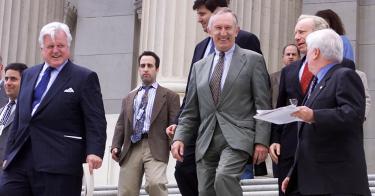In addition to the anniversary of D-Day, June 6 also marks the date on which Senator Jim Jeffords of Vermont switched parties to hand Senate control to the Democrats.
The year was 2001, and profound changes were already underway for the judicial-appointment process. Only a few weeks after President George W. Bush took office, Senate Democratic Leader Tom Daschle (S.D.) vowed to use “whatever means necessary” to fight his judicial nominations. In early May, Senate Democrats huddled with liberal law professors and strategists at a Florida retreat where, as the New York Times reported, “a principal topic was forging a unified party strategy to combat the White House on judicial nominees.”
And so a new chapter in confirmation obstruction began. The Jeffords switch made the early going a pretty easy lift. All that new Judiciary Committee Chairman Patrick Leahy (D-Vt.) had to do was . . . nothing. No hearing, no confirmation.
Just a month earlier, on May 9, Bush nominated eleven men and women to the U.S. Court of Appeals in circuits across the country. Priscilla Owen, nominated to the Fifth Circuit, received a unanimous well qualified rating from the American Bar Association. HEARING DENIED. John Roberts, nominated to the D.C. Circuit, also received a unanimous well qualified ABA rating. HEARING DENIED. When he was confirmed two years later, after Republicans regained Senate control, not a single senator voted against him.
Even a nationally respected constitutional scholar like Michael McConnell — yes, he also received a unanimous well qualified rating — was kept in limbo for 16 months before Leahy allowed a hearing. Like Roberts, McConnell was confirmed without any opposition.
Democrats also began slowing the confirmation process by forcing the Senate to take time-consuming roll call votes which require the presence of all senators. In Bush’s first term, the Senate took 131 roll call votes on judicial nominations, more than in the previous 212 years combined. The roll calls accomplished nothing; 89 percent of them were unanimous — that’s right, no opposition at all.
When Democrats returned to the minority in the 108th Congress, they began implementing the strategy developed at their May 2001 retreat. For the first time in history, the filibuster was used to defeat judicial nominees who would have been confirmed if allowed a final vote.
Today, under a new Republican president, Democrats are continuing their “whatever means necessary” strategy. At this point during the Barack Obama administration, only 14 percent of his judicial nominees had received even a single vote against confirmation; that figure has jumped to 75 percent for Trump nominees.
The average Senate Republican had voted against eight percent of Obama’s judicial nominees at this point, while the average Senate Democrat has voted against 43 percent of Trump’s judicial nominees.
Jeffords’s switch was more than one senator changing parties. It also triggered a radical change in the norms of the confirmation process.
This piece originally appeared in National Review




